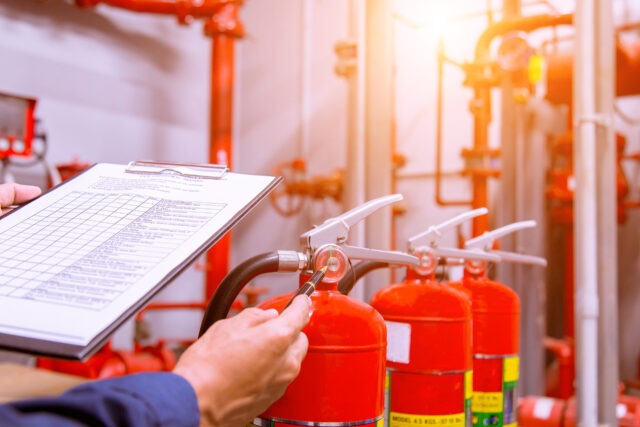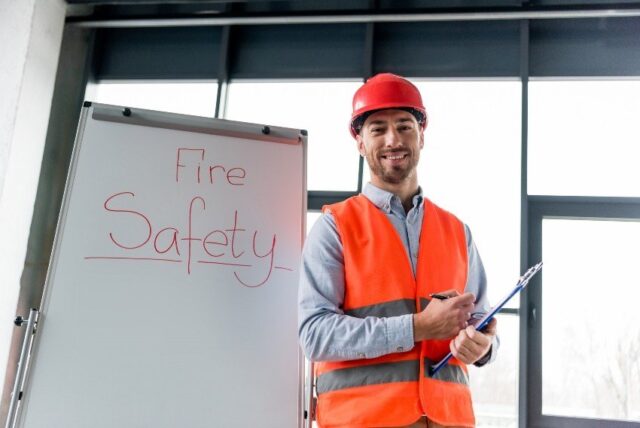
Are you ready to protect yourself, your loved ones, and your property from the devastating effects of a fire? If so, conducting a comprehensive fire risk assessment is an essential step to take.
By identifying potential fire hazards, evaluating the likelihood of a fire occurring, and implementing effective prevention and mitigation strategies, you can significantly reduce your risk of experiencing a fire.
In this step-by-step guide, we will outline the key components of a comprehensive fire risk assessment that you can follow to safeguard your home or workplace.
Identifying Potential Fire Hazards

The first step in conducting a fire risk assessment is to identify all potential fire hazards in the area. These can include anything from faulty electrical equipment to flammable materials or hazardous chemicals.
It’s important to be as thorough as possible in this step, leaving no stone unturned. Remember, prevention is always better than cure, so identifying all potential fire hazards is critical in reducing the risk of a fire.
Evaluating The Likelihood of a Fire Occurring
Once you have identified all potential fire hazards, the next step is to evaluate the likelihood of a fire occurring.
This involves assessing factors such as the frequency and duration of occupancy, the type of activities that take place in the area, and the presence of ignition sources.
By evaluating these factors, you can gain a better understanding of the likelihood of a fire occurring and adjust your prevention and mitigation strategies accordingly.
Implementing Effective Prevention and Mitigation Strategies

Now that you have identified potential fire hazards and evaluated the likelihood of a fire occurring, the next step is to implement effective prevention and mitigation strategies.
These can include anything from installing smoke detectors and fire alarms to conducting regular maintenance checks on electrical equipment and implementing fire safety training for all occupants.
It’s important to tailor your prevention and mitigation strategies to the specific needs of your home or workplace to ensure maximum effectiveness.
Evaluating the Adequacy of Existing Fire Safety Measures
To assess the adequacy of these measures and make any additional recommendations for improvement:
Inspect all areas of the structure for potential hazards and determine which areas could be improved with new equipment or supplies.
Identify existing fire safety systems and determine whether they meet recognized standards for fire detection, mitigation, evacuation procedures, etc., taking into account the building’s overall size and layout.
Test existing safety systems to make sure they are functioning properly; if not, recommend updates or repairs as needed.
Assess any existing practices such as monitoring or maintenance checks in order to ensure consistent performance.
Ascertain whether employees are trained in proper emergency response protocols such as escape routes and evacuation plans if a fire were to occur onsite.
Ensure adequate supplies such as extinguishers or blankets are readily available on each floor of a multi-story structure (if necessary).
Inspect external areas around windows and doorways for potential entry points or exit paths if necessary during a response scenario; suggest changes if necessary in order to increase usable pathways if needed during a response scenario.
Creating An Emergency Response Plan

Even with the most comprehensive fire prevention and mitigation strategies in place, it’s still possible for a fire to occur. That’s why it’s important to have an emergency response plan in place.
Here’s a list of items to consider when creating your emergency response plan:
Emergency Contacts
Have a list of emergency contacts that occupants can easily access in case of a fire, including the fire department and medical services.
Evacuation Procedures
Have clearly marked evacuation routes and ensure that all occupants are aware of them. Identify any potential obstacles or barriers to a safe evacuation and have strategies to overcome them.
Designated Meeting Points
Establish safe designated meeting points outside the building for all occupants to gather after evacuating.
Communication Procedures
Establish a communication plan to ensure that all occupants are accounted for during an emergency. Assign a person to be responsible for checking that everyone is present and ensuring that everyone is aware of who that person is.
Training
Provide fire safety training to all occupants so that they are familiar with the emergency response plan and know what to do in the event of a fire.
By having a well-prepared emergency response plan in place, you can help to minimize the potential for injury or loss of life in the event of a fire.
Regularly Reviewing and Updating Your Fire Risk Assessment

Finally, it’s important to regularly review and update your fire risk assessment to ensure that it remains effective over time. Ensure you go with a reliable company like GF Fire Solutions to give you peace of mind that your fire risk assessment has been done thoroughly.
As your home or workplace changes, so too will the potential fire hazards and the likelihood of a fire occurring. Regularly reviewing and updating your fire risk assessment can help to identify new hazards and ensure that your prevention and mitigation strategies are still appropriate and effective.
In particular, organizations should pay close attention to changes in the:
- The number of people working in or visiting areas where there is a potential fire hazard;
- The types of materials and/or activities taking place where there is an increased risk of fire;
- Any alterations made to buildings or other structures on the premises;
- The introduction of new sources of energy such as open flame heaters, equipment powered by fuel sources (such as natural gas), etc.;
- The installation of new communication systems and any other systems pertinent to the early warning in case of emergency;
- Changes in local environmental factors such as weather patterns, air quality, etc.;
- Any measures taken following previous reviews to reduce potential risks from fires.
A thorough review should also include an analysis and identification of any staff members who may lack the necessary skills for responding to a real-life emergency situation. Additionally, organizations should make sure that their personnel is regularly educated about how reports are carried out and how hazardous materials are stored safely. Lastly, organizations must also ensure that their premises remain compliant with all applicable laws regarding prevention and response measures needed for fires on site.
Conclusion
Conducting a comprehensive fire risk assessment is an essential step to take in protecting yourself, your loved ones, and your property from the devastating effects of a fire.
By identifying potential fire hazards, evaluating the likelihood of a fire occurring, and implementing effective prevention and mitigation strategies you can significantly reduce your risk of experiencing a fire.
Remember, taking action now can help to prevent a fire from ever occurring, and ultimately, save lives.












